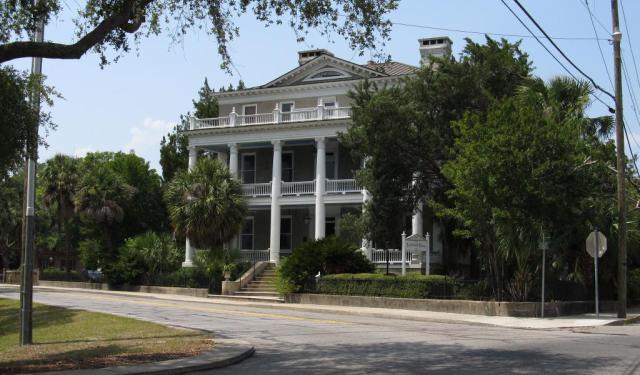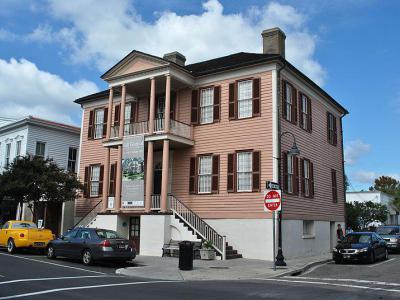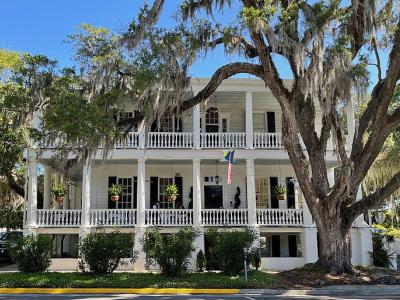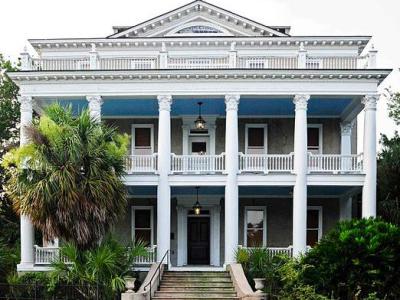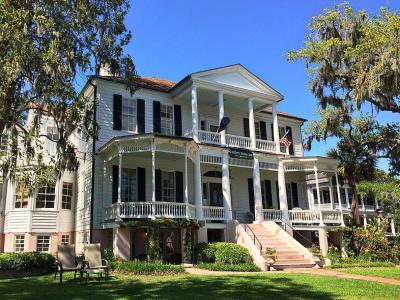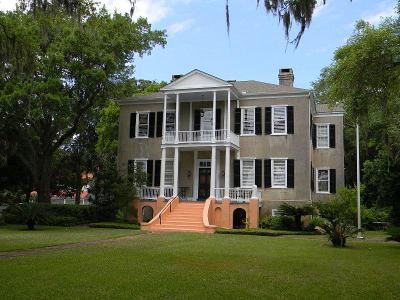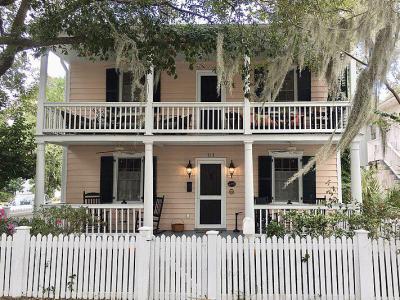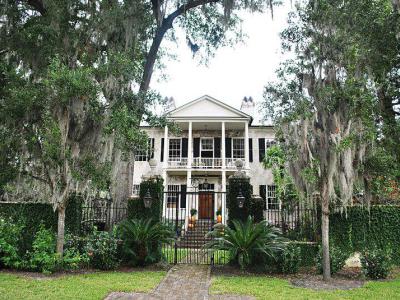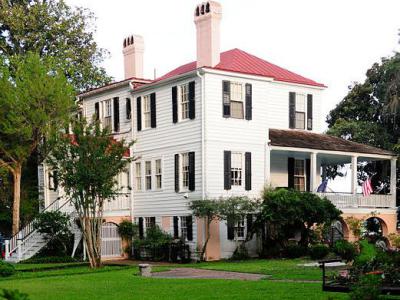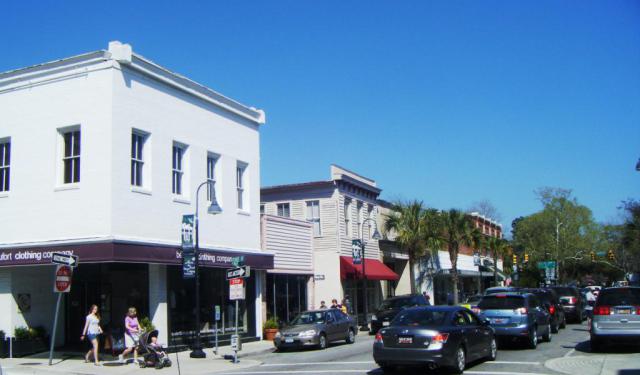Beaufort Historic Houses Walking Tour (Self Guided), Beaufort
Beaufort, South Carolina, a city rich in history, is full of architectural gems: stately, historic properties reflecting a variety of styles. The local Historic District is a mix of Federal, Neoclassical, and Greek Revival architecture, with many homes predating the Civil War.
The Barnwell-Gough House, an exquisite example of Federal-style architecture, stands proudly with its classic symmetry and graceful details. A couple of blocks away, The Cobbler's Cottage, a quaint 18th-century dwelling, exudes charm with its Lowcountry architecture and lush garden.
The Robert Smalls House holds a special place in history, as it was once the home of a remarkable figure who escaped slavery and became a prominent politician. The house stands as a testament to his courage and determination.
Marshlands, an antebellum mansion, exudes Southern grandeur with its mix of Adam and West Indies design and stunning river views. The John Mark Verdier House, another fine piece of Federal architecture, is adorned with white-pillared columns and front porches.
Rhett House Inn, a luxurious inn housed in a Greek Revival mansion, offers a taste of Southern hospitality in an enchanting setting, while the Anchorage, another Greek Revival treasure, stands as one of Beaufort's most iconic landmarks.
The John A Cuthbert House, a classic antebellum-era gem, delights with its distinctive Southern features and charming porches.
Back in the day, the city actively employed tabby construction with oyster shells and lime ash, which was an early form of concrete to make it stand out from other cities of the period. Tabby Manse is one such unique structure made from a blend of oyster shells and other materials, showcasing the region's distinctive architectural history.
The rich tapestry of historic houses in Beaufort tells the story of its vibrant past. Exploring them is like stepping back in time. So put on your walking shoes and embark on a captivating journey through time with the help of our self-guided tour!
The Barnwell-Gough House, an exquisite example of Federal-style architecture, stands proudly with its classic symmetry and graceful details. A couple of blocks away, The Cobbler's Cottage, a quaint 18th-century dwelling, exudes charm with its Lowcountry architecture and lush garden.
The Robert Smalls House holds a special place in history, as it was once the home of a remarkable figure who escaped slavery and became a prominent politician. The house stands as a testament to his courage and determination.
Marshlands, an antebellum mansion, exudes Southern grandeur with its mix of Adam and West Indies design and stunning river views. The John Mark Verdier House, another fine piece of Federal architecture, is adorned with white-pillared columns and front porches.
Rhett House Inn, a luxurious inn housed in a Greek Revival mansion, offers a taste of Southern hospitality in an enchanting setting, while the Anchorage, another Greek Revival treasure, stands as one of Beaufort's most iconic landmarks.
The John A Cuthbert House, a classic antebellum-era gem, delights with its distinctive Southern features and charming porches.
Back in the day, the city actively employed tabby construction with oyster shells and lime ash, which was an early form of concrete to make it stand out from other cities of the period. Tabby Manse is one such unique structure made from a blend of oyster shells and other materials, showcasing the region's distinctive architectural history.
The rich tapestry of historic houses in Beaufort tells the story of its vibrant past. Exploring them is like stepping back in time. So put on your walking shoes and embark on a captivating journey through time with the help of our self-guided tour!
How it works: Download the app "GPSmyCity: Walks in 1K+ Cities" from Apple App Store or Google Play Store to your mobile phone or tablet. The app turns your mobile device into a personal tour guide and its built-in GPS navigation functions guide you from one tour stop to next. The app works offline, so no data plan is needed when traveling abroad.
Beaufort Historic Houses Walking Tour Map
Guide Name: Beaufort Historic Houses Walking Tour
Guide Location: USA » Beaufort (See other walking tours in Beaufort)
Guide Type: Self-guided Walking Tour (Sightseeing)
# of Attractions: 9
Tour Duration: 2 Hour(s)
Travel Distance: 2.5 Km or 1.6 Miles
Author: DanaOffice
Sight(s) Featured in This Guide:
Guide Location: USA » Beaufort (See other walking tours in Beaufort)
Guide Type: Self-guided Walking Tour (Sightseeing)
# of Attractions: 9
Tour Duration: 2 Hour(s)
Travel Distance: 2.5 Km or 1.6 Miles
Author: DanaOffice
Sight(s) Featured in This Guide:
- John Mark Verdier House
- Rhett House Inn
- The Anchorage
- John A. Cuthbert House
- Tabby Manse
- The Cobbler's Cottage
- Barnwell-Gough House
- Robert Smalls House
- Marshlands
1) John Mark Verdier House
The John Mark Verdier House is often regarded as one of Beaufort's most iconic and well-preserved historic homes. John Mark Verdier, a French Huguenot, played a pivotal role in Beaufort's history. Arriving in Beaufort, he embarked on a successful journey as a merchant and later as a plantation owner, accumulating wealth through the highly profitable Indigo trade of the late 18th and early 19th centuries. Verdier acquired over 1,000 acres of Sea Island cotton fields and plantations, prompting the construction of a grand Federal-style mansion in Beaufort's historic downtown district. The mansion became an iconic local landmark and even served as a preferred residence for Union Soldiers during the Civil War.
This stately home, adorned with two levels of white pillared columns and front porches, symbolized his ascent to the upper echelons of Beaufort's society. It is furnished with a collection of period-appropriate antiques, providing a glimpse into the furnishings and decor of the time when the house was originally occupied.
Today, the John Mark Verdier House serves as a museum and cultural center. It offers visitors the opportunity to explore the historic residence and learn about the history of Beaufort and its inhabitants. Guided tours of the house are available, providing visitors with insights into the architectural details, the lifestyle of the era, and the historical context of Beaufort during the 19th century. The tour offers insights into various intriguing aspects, including the home's distinction as the first Beaufort residence to have a telephone and its original design that positioned kitchens, bathrooms, and closets outside the main house.
The house museum also boasts three compelling exhibits focusing on Robert Smalls, the first African American to serve in the U.S. Congress in 1875, a collection of Civil War-era photos by local Samuel Cooley, and an exhibit honoring the Beaufort Volunteer Artillery, who valiantly served in both the American Revolution and the Civil War.
This stately home, adorned with two levels of white pillared columns and front porches, symbolized his ascent to the upper echelons of Beaufort's society. It is furnished with a collection of period-appropriate antiques, providing a glimpse into the furnishings and decor of the time when the house was originally occupied.
Today, the John Mark Verdier House serves as a museum and cultural center. It offers visitors the opportunity to explore the historic residence and learn about the history of Beaufort and its inhabitants. Guided tours of the house are available, providing visitors with insights into the architectural details, the lifestyle of the era, and the historical context of Beaufort during the 19th century. The tour offers insights into various intriguing aspects, including the home's distinction as the first Beaufort residence to have a telephone and its original design that positioned kitchens, bathrooms, and closets outside the main house.
The house museum also boasts three compelling exhibits focusing on Robert Smalls, the first African American to serve in the U.S. Congress in 1875, a collection of Civil War-era photos by local Samuel Cooley, and an exhibit honoring the Beaufort Volunteer Artillery, who valiantly served in both the American Revolution and the Civil War.
2) Rhett House Inn
The Rhett House Inn was once the cherished residence of Thomas Moore Rhett and his wife, Caroline Barnwell, notable figures in South Carolina during the 1800s. The Inn's location in the Point neighborhood places it squarely within the Beaufort Historic District, surrounded by other architectural gems that contribute to the town's unique charm.
Today, the Rhett House Inn has evolved into a Four Diamond bed and breakfast Inn, inviting guests to step back in time while indulging in modern luxury. Its historic character is carefully preserved, providing visitors with an authentic glimpse into the past.
Nestled within the Beaufort Historic District, the Rhett House Inn is not only a comfortable haven for travelers but also a gateway to the town's rich history and cultural heritage. Guests can explore the nearby historic sites, wander through the charming streets, and immerse themselves in the captivating stories of Beaufort.
Today, the Rhett House Inn has evolved into a Four Diamond bed and breakfast Inn, inviting guests to step back in time while indulging in modern luxury. Its historic character is carefully preserved, providing visitors with an authentic glimpse into the past.
Nestled within the Beaufort Historic District, the Rhett House Inn is not only a comfortable haven for travelers but also a gateway to the town's rich history and cultural heritage. Guests can explore the nearby historic sites, wander through the charming streets, and immerse themselves in the captivating stories of Beaufort.
3) The Anchorage
The Anchorage, also known as the William Elliott House, is a historic residence dating back to 1776. The origins of the William Elliott House are shrouded in some speculation, but it is widely recognized as a pre-Revolutionary structure with deep historical significance. Some historical accounts suggest that it was constructed by William Elliott, I, the father of William, Ralph, and Stephen Elliott. However, according to records from the National Register, it was Ralph Emms Elliott, a planter and owner of Cedar Grove Plantation, who built the house. Ralph Emms Elliott subsequently bequeathed the house to his nephew, William Elliott III, in 1806.
William Elliott III was a multifaceted individual, known for his exceptional success in politics, plantation management, sportsmanship, and writing. As mayor of Beaufort in 1825, he hosted the Marquis de Lafayette during the Frenchman's brief visit to the town. Elliott was not only a prosperous planter but also a passionate sportsman and author. In 1846, he penned "Carolina Sports by Land and Water," considered one of the earliest sportsman narratives.
William Elliott III's political career was equally distinguished, with service in the South Carolina House of Representatives and the South Carolina Senate. He notably resigned from the state senate due to his opposition to nullification, demonstrating his unwavering principles and convictions.
The Anchorage also had the honor of being the residence of Rear Admiral Lester Beardslee, a Naval officer, from 1891 to 1894 when he was in command of the Port Royal Naval Station. His intention was to retire to this historic house in 1901.
This architectural treasure was officially recognized for its historical significance when it was listed on the National Register of Historic Places in 1971. It is situated within the Beaufort Historic District, a National Historic Landmark District, further highlighting its importance in the cultural and architectural heritage of Beaufort.
In 2014, the Anchorage found new stewards in Frank and Amy Lesesne, who converted it into a boutique waterfront inn, ensuring that this historic gem continues to be cherished and preserved for future generations to appreciate and enjoy.
William Elliott III was a multifaceted individual, known for his exceptional success in politics, plantation management, sportsmanship, and writing. As mayor of Beaufort in 1825, he hosted the Marquis de Lafayette during the Frenchman's brief visit to the town. Elliott was not only a prosperous planter but also a passionate sportsman and author. In 1846, he penned "Carolina Sports by Land and Water," considered one of the earliest sportsman narratives.
William Elliott III's political career was equally distinguished, with service in the South Carolina House of Representatives and the South Carolina Senate. He notably resigned from the state senate due to his opposition to nullification, demonstrating his unwavering principles and convictions.
The Anchorage also had the honor of being the residence of Rear Admiral Lester Beardslee, a Naval officer, from 1891 to 1894 when he was in command of the Port Royal Naval Station. His intention was to retire to this historic house in 1901.
This architectural treasure was officially recognized for its historical significance when it was listed on the National Register of Historic Places in 1971. It is situated within the Beaufort Historic District, a National Historic Landmark District, further highlighting its importance in the cultural and architectural heritage of Beaufort.
In 2014, the Anchorage found new stewards in Frank and Amy Lesesne, who converted it into a boutique waterfront inn, ensuring that this historic gem continues to be cherished and preserved for future generations to appreciate and enjoy.
4) John A. Cuthbert House
The John A. Cuthbert House, a residence erected in the year 1811 in Beaufort, earned a coveted spot on the National Register of Historic Places in 1972. It finds itself situated within the Beaufort Historic District, a locale of remarkable historical importance, granted the esteemed status of being a National Historic Landmark.
The house showcases classic antebellum architecture, characterized by its distinctive Southern features. It is a fine example of the architectural style prevalent in the pre-Civil War South, reflecting the elegance and craftsmanship of the era.
The John A. Cuthbert House has passed through various owners over the years. Its history is intertwined with the development of Beaufort as a thriving coastal community.
Today, the John A. Cuthbert House serves as a charming bed and breakfast inn. Visitors have the opportunity to stay in a historic setting and experience the gracious hospitality of the Lowcountry. The innkeepers and staff at the John A. Cuthbert House are known for their warm Southern hospitality.
The property features beautifully landscaped grounds, including gardens and outdoor seating areas. These provide a serene setting for relaxation and enjoyment of the natural beauty of the Lowcountry.
The house showcases classic antebellum architecture, characterized by its distinctive Southern features. It is a fine example of the architectural style prevalent in the pre-Civil War South, reflecting the elegance and craftsmanship of the era.
The John A. Cuthbert House has passed through various owners over the years. Its history is intertwined with the development of Beaufort as a thriving coastal community.
Today, the John A. Cuthbert House serves as a charming bed and breakfast inn. Visitors have the opportunity to stay in a historic setting and experience the gracious hospitality of the Lowcountry. The innkeepers and staff at the John A. Cuthbert House are known for their warm Southern hospitality.
The property features beautifully landscaped grounds, including gardens and outdoor seating areas. These provide a serene setting for relaxation and enjoyment of the natural beauty of the Lowcountry.
5) Tabby Manse
The Tabby Manse, also recognized as the Thomas Fuller House, is a rare example of early coastal construction, distinguished by its remarkable use of tabby.
Constructed around 1786 by Thomas Fuller, a prominent local planter, the Tabby Manse remains one of the few existing early buildings along the South Carolina coast with exterior walls crafted entirely from tabby. The material's composition, created from the abundant shells of oysters, is a testament to the resourcefulness and creativity of early builders in the region. The walls, boasting a substantial thickness of more than two feet, are covered with stucco, carefully scored to emulate the appearance of stone blocks.
One of the defining features of the Tabby Manse is its classical proportions and exceptional craftsmanship. The house's design reflects a timeless elegance and showcases the artistry of its builders. It serves as a testament to the architectural ingenuity of its era, embodying the enduring legacy of craftsmanship and construction techniques that have left an indelible mark on the region's architectural heritage.
As one of only a handful of early American residences with exterior walls constructed entirely of tabby, the Tabby Manse holds a special place in architectural history. It offers a tangible connection to the past, preserving not only the building itself but also the traditions, materials, and skills that defined early coastal construction in South Carolina.
Constructed around 1786 by Thomas Fuller, a prominent local planter, the Tabby Manse remains one of the few existing early buildings along the South Carolina coast with exterior walls crafted entirely from tabby. The material's composition, created from the abundant shells of oysters, is a testament to the resourcefulness and creativity of early builders in the region. The walls, boasting a substantial thickness of more than two feet, are covered with stucco, carefully scored to emulate the appearance of stone blocks.
One of the defining features of the Tabby Manse is its classical proportions and exceptional craftsmanship. The house's design reflects a timeless elegance and showcases the artistry of its builders. It serves as a testament to the architectural ingenuity of its era, embodying the enduring legacy of craftsmanship and construction techniques that have left an indelible mark on the region's architectural heritage.
As one of only a handful of early American residences with exterior walls constructed entirely of tabby, the Tabby Manse holds a special place in architectural history. It offers a tangible connection to the past, preserving not only the building itself but also the traditions, materials, and skills that defined early coastal construction in South Carolina.
6) The Cobbler's Cottage
The Cobbler's Cottage, a charming historic residence dating back to around 1870, is nestled within the Beaufort Historic District, a United States National Historic Landmark.
Beaufort, SC, received its charter in 1711, and its city layout was meticulously planned to take advantage of the favorable southern breezes from the Beaufort River. Homes were strategically constructed facing south along the river bluff, a design known as Beaufort Style Architecture. This architectural approach, often characterized by stately T-shaped homes, was designed to maximize the capture of the refreshing river breezes.
While Beaufort's history is marked by the grandeur of plantation-style mansions, the Cobbler's Cottage stands as a unique representation of the common working class that played a crucial role in servicing the needs of the affluent Planters in the area known as "The Old Commons."
The cottage earned its name, the Cobbler's Cottage, due to the presence of a cobbler's shop on the property, located in front of the cottage, which operated for several decades, from 1899 to as late as 1958. This historical connection to a skilled tradesperson highlights the role that common working-class individuals played in supporting the local community and the Planters.
Beaufort, SC, received its charter in 1711, and its city layout was meticulously planned to take advantage of the favorable southern breezes from the Beaufort River. Homes were strategically constructed facing south along the river bluff, a design known as Beaufort Style Architecture. This architectural approach, often characterized by stately T-shaped homes, was designed to maximize the capture of the refreshing river breezes.
While Beaufort's history is marked by the grandeur of plantation-style mansions, the Cobbler's Cottage stands as a unique representation of the common working class that played a crucial role in servicing the needs of the affluent Planters in the area known as "The Old Commons."
The cottage earned its name, the Cobbler's Cottage, due to the presence of a cobbler's shop on the property, located in front of the cottage, which operated for several decades, from 1899 to as late as 1958. This historical connection to a skilled tradesperson highlights the role that common working-class individuals played in supporting the local community and the Planters.
7) Barnwell-Gough House
The Barnwell-Gough House is named after two prominent families who lived there during its long history. The Barnwell family, originally from nearby Charleston, acquired the property in the 18th century. Later, it became the residence of the Gough family. The house's historical importance lies in its representation of the architectural and social history of Beaufort.
The house is a fine example of Federal-style architecture, characterized by its symmetrical facade, ornate detailing, and double-tiered piazzas (verandas) that wrap around the front and one side of the building. These features reflect the architectural tastes of the era.
The house is situated within the historic district of Beaufort, known for its charming and well-preserved antebellum architecture. The town itself boasts a rich history, and the Barnwell-Gough House is an integral part of that heritage.
While it may not always be open to the public, the Barnwell-Gough House is a notable sight to admire from the outside when visiting Beaufort. The picturesque setting, with its lush gardens and historic ambiance, offers an excellent opportunity for a leisurely stroll and photography.
The house is a fine example of Federal-style architecture, characterized by its symmetrical facade, ornate detailing, and double-tiered piazzas (verandas) that wrap around the front and one side of the building. These features reflect the architectural tastes of the era.
The house is situated within the historic district of Beaufort, known for its charming and well-preserved antebellum architecture. The town itself boasts a rich history, and the Barnwell-Gough House is an integral part of that heritage.
While it may not always be open to the public, the Barnwell-Gough House is a notable sight to admire from the outside when visiting Beaufort. The picturesque setting, with its lush gardens and historic ambiance, offers an excellent opportunity for a leisurely stroll and photography.
8) Robert Smalls House
The Robert Smalls House is a historic dwelling with a remarkable story and a significant place in American history. Constructed in 1843 and subsequently modified over the years, this house has earned its status as a National Historic Landmark, primarily due to its profound association with Robert Smalls (1839-1915).
Robert Smalls, born into the bonds of slavery, is an enduring symbol of courage and resilience. His incredible journey from bondage to freedom and political prominence is intricately linked to the Robert Smalls House. One of the pivotal moments in Smalls' life occurred during the American Civil War when he commandeered the CSS Planter, a Confederate vessel, and sailed it to freedom, along with fellow enslaved individuals.
Following the Civil War and during the era of Reconstruction, Robert Smalls continued to make history. He represented South Carolina in the United States House of Representatives, becoming one of the first African Americans to hold such a position. His political career was characterized by his commitment to civil rights and his advocacy for the rights of formerly enslaved individuals.
Robert Smalls, born into the bonds of slavery, is an enduring symbol of courage and resilience. His incredible journey from bondage to freedom and political prominence is intricately linked to the Robert Smalls House. One of the pivotal moments in Smalls' life occurred during the American Civil War when he commandeered the CSS Planter, a Confederate vessel, and sailed it to freedom, along with fellow enslaved individuals.
Following the Civil War and during the era of Reconstruction, Robert Smalls continued to make history. He represented South Carolina in the United States House of Representatives, becoming one of the first African Americans to hold such a position. His political career was characterized by his commitment to civil rights and his advocacy for the rights of formerly enslaved individuals.
9) Marshlands
Built around 1814, Marshlands, also known as the James Robert Verdier House, was the residence of Dr. James Robert Verdier, a prominent figure in Beaufort's history. Dr. Verdier was known for his groundbreaking work in discovering early treatments for yellow fever, a disease prevalent during the era. During the American Civil War, Marshlands played a crucial role as the headquarters for the United States Sanitary Commission.
Marshlands features a two-story wood-frame structure situated on a raised foundation crafted from pink tabby cement, showcasing an intricate arcade of arches. Its exterior is elegantly clad in wooden clapboards, creating a striking visual impression.
One of the notable features of Marshlands is its distinctive design, which melds elements of the Adam style with influences from the West Indies. This unique combination is evident in the arcade-style basement and the single-story porch that gracefully wraps around three sides of the house. Notably, this design deviates from the typical two-story porches seen in many Beaufort houses.
Today, Marshlands remains in private ownership and is not open to the public. While its doors may not be accessible to tourists, its presence enriches the architectural and historical tapestry of Beaufort, serving as a symbol of the town's rich heritage.
Marshlands features a two-story wood-frame structure situated on a raised foundation crafted from pink tabby cement, showcasing an intricate arcade of arches. Its exterior is elegantly clad in wooden clapboards, creating a striking visual impression.
One of the notable features of Marshlands is its distinctive design, which melds elements of the Adam style with influences from the West Indies. This unique combination is evident in the arcade-style basement and the single-story porch that gracefully wraps around three sides of the house. Notably, this design deviates from the typical two-story porches seen in many Beaufort houses.
Today, Marshlands remains in private ownership and is not open to the public. While its doors may not be accessible to tourists, its presence enriches the architectural and historical tapestry of Beaufort, serving as a symbol of the town's rich heritage.
Walking Tours in Beaufort, South Carolina
Create Your Own Walk in Beaufort
Creating your own self-guided walk in Beaufort is easy and fun. Choose the city attractions that you want to see and a walk route map will be created just for you. You can even set your hotel as the start point of the walk.
Beaufort Introduction Walking Tour
Named the "Most Romantic City" in South Carolina, Beaufort – located just outside of Hilton Head – is overflowing with charm.
This coastal gem has a storied past that stretches back 500 years as the site of the second European landing in North America, the Spanish exploration led by Captain Pedro de Salazar. In 1711, British colonists founded a city in the area and named it for... view more
Tour Duration: 2 Hour(s)
Travel Distance: 3.1 Km or 1.9 Miles
This coastal gem has a storied past that stretches back 500 years as the site of the second European landing in North America, the Spanish exploration led by Captain Pedro de Salazar. In 1711, British colonists founded a city in the area and named it for... view more
Tour Duration: 2 Hour(s)
Travel Distance: 3.1 Km or 1.9 Miles
The Most Popular Cities
/ view all
